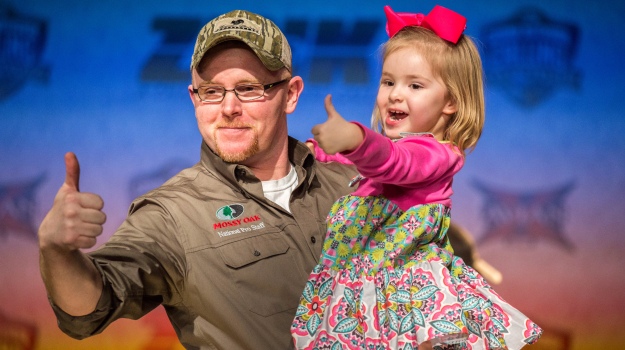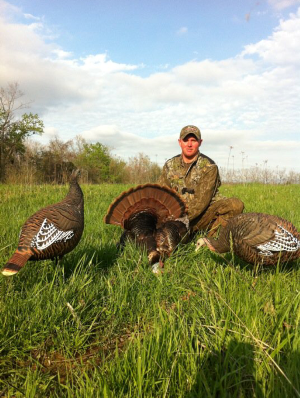
Another call that I use when I'm hunting that I think most other hunters don’t use as effectively as they can is soft purring. Most turkey hunters judge what a turkey can hear based on their own ability to hear. Even though we all know that a turkey’s ability to hear is much greater than our own, we don’t use that fact oftentimes when we talk to gobblers. If I have a gobbler that’s hung-up, I try to get as close as I possibly can to him without his seeing me. Then I rely on my feeding calls to get that tom to walk within gun range.
Hen turkeys have a whine that’s very low-pitched. A hunter has to be within about 10 yards to hear that low-pitched whine that a hen turkey produces when she’s feeding. Being able to give those really low, soft whines adds a lot of realism to your calling. Many people use a slate or a glass call to give those low whines of a hen turkey, but I give those little feeding calls on my diaphragm call. Most people probably won’t believe that a turkey that’s hung up at 75 yards can hear those low calls - generally because, the hunters can’t hear those calls if they’re that far away from the caller. I’ll add in some really soft clucks and some almost inaudible yelps. I add one more call that I really think does the trick but is hard to describe. Hens make a sound like a person makes after they yawn. Unless you're paying very close attention, and you're close to that person, you'll never hear the little sound he/she makes when they exhale after they yawn. Only hens make that sound – not toms. Again, because the call’s so low and so quiet, most hunters will say, “There's no way that a gobbler can hear those little sounds.” But it’s a sound I mix in with my low clucks and purrs. It almost sounds like a hen’s breathing.
 Once I set up on a gobbler I found not far from my house. The tom was coming to me; but then, he hung up about 150 yards from me. I made cutts and yelps to the turkey, and the bird would gobble, but he’d never come in to where I was. He was out in the field, and he was the slowest walking turkey I'd ever encountered. That bird walked within 75 yards of me, but it took him about 4 hours to go that distance. When the gobbler was at about 60 yards, I started giving him those soft whines and those little breathing sounds. Although I mixed them in with soft clucking and purring calls, the gobbler wasn’t convinced that I was a hen, until I added in those breathing sounds. Then he came on in to within gun range. Over the years, I've learned that soft whines with those little breathing sounds mixed in have been responsible for me taking more gobblers than any other calls I can use.
Once I set up on a gobbler I found not far from my house. The tom was coming to me; but then, he hung up about 150 yards from me. I made cutts and yelps to the turkey, and the bird would gobble, but he’d never come in to where I was. He was out in the field, and he was the slowest walking turkey I'd ever encountered. That bird walked within 75 yards of me, but it took him about 4 hours to go that distance. When the gobbler was at about 60 yards, I started giving him those soft whines and those little breathing sounds. Although I mixed them in with soft clucking and purring calls, the gobbler wasn’t convinced that I was a hen, until I added in those breathing sounds. Then he came on in to within gun range. Over the years, I've learned that soft whines with those little breathing sounds mixed in have been responsible for me taking more gobblers than any other calls I can use.
In Kentucky where I hunt, we’re allowed to take one gobbler in the fall, three hens during the fall and two gobblers during the spring for a total of six turkeys. If I also hunt Ohio and/or Tennessee, I’ll usually take a total of eight to 10 turkeys during the season. This spring I’m going to Tuscaloosa, Alabama, to hunt Alabama gobblers. Chad Hoggle who owns American Strutter has invited me down to hunt with him on property that he hunts.
Although I love to hunt turkeys, I also love turkey calling contests. Winning the 2017 NWTF’s Grand National Open Division was very special for me, because my wife, Whittney, and my daughter, 4-year-old Sadie, were with me at the event. Sadie really wants to learn to call turkeys, but I won’t let her use a mouth diaphragm yet. However, she has a friction call that she practices on all the time. Sadie is probably the toughest judge I've ever had. When I start practicing my turkey calls at home, she’ll get a weird look on her face if she doesn’t like the call. However, if I give her a call she really likes, she’ll give me a thumbs-up. After the Grand Nationals, I had Sadie on the stage with me, and she gave me a thumbs-up. So, I knew I had convinced the toughest judge at the contest that I had called turkeys really well.






























